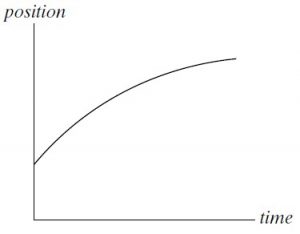In this activity, Physics 11 students will not only be able to “talk the talk” but “walk the walk”. Fully understanding position-time graphs and velocity time graphs have plagued rookie Physics students for decades (Struck & Yerrick, 2009). In my own experience, typical misconceptions involve thinking that if the position-time graph has a positive slope, then the object is moving up a hill. Sometimes students will think that a curve, as shown, means that an object is speeding up initially, then slowing down. It seems that for as many correct interpretations there are, there are countless incorrect interpretations!
a curve, as shown, means that an object is speeding up initially, then slowing down. It seems that for as many correct interpretations there are, there are countless incorrect interpretations!
In their study, Struck and Yerrick investigated if it was more effective to have students use probeware to analysis motion then to use video analysis or vice versa. Not surprisingly, they found that both groups of students had statistically significant improvements to their understanding and that it did not matter in which order the students underwent their inquiries. The authors concluded that since the digital analysis took much longer to undergo, that if a teacher were only to do one of these approaches, that using the Probeware was the most time effective and had almost the equivalent final results.
Without question, the main obstacle that a teacher will encounter when using Probeware, such as Vernier, is the cost. Over the years, I have slowly amassed a set of motion detectors and interfaces, which was also helped by a grant that my school received that was earmarked for improving students’ direct experiences with science.
The activity that I have created uses the Vernier system along with the LfU framework, as outlined in Edelson’s paper, “ Learning-for-Use: A Framework for the Design of Technology-Supported Inquiry Activities” (2000). Having students move their bodies, to create the graphs motivates and heightens the curiosity of the students. As the graphs are created in real time, students receive immediate feedback. They must work in groups, so the social-collaborative construction of knowledge is fully activated. After engaging in a “direct experience” with the equipment, students will then answer questions within the shared Google Doc, to ensure that the principles of physics are not only understood but reinforced. The questions also serve to provide opportunity to apply the newly acquired knowledge in a meaningful way. Lastly, groups are required to reflect on their key take-aways from the activity, along with an opportunity to state what further questions they may have.
What I particularly like about this activity, is that it also exploits the research surrounding embodied and embedded cognition. No longer should we limit our understanding of cognition to only the one organ: the brain. Learning also takes place when any physical activity is associated with the endeavor. Activities that challenge students, pique their curiosity and provide “fruitful” new tidbits of knowledge that can assist them with future problems, are optimal, should the new knowledge wish to be adapted (Winn, 2003).
To go a step further, I would then follow the Vernier Activity with a Peer Instruction lesson, that reinforced these concepts. Through the Peer Instruction Framework, individuals are able to have their misconceptions dispelled through conversation with their peers. As the questions would directly relate to the Vernier activity, students would be able to apply their knowledge the next day, making use of all three mechanisms for adaption of knowledge:
- Creating genetic algorithms: the “if-then” rules we construct when interacting with our environment and adapting our knowledge due to collecting “fruitful” information
- Rule Discovery: rules would have been crafted during the Vernier activity but then further entrenched by applying the rules to the Peer Instruction questions
- Crossover: applying the algorithms and rules in new situations could lead to rules combining into new rules for more complex situations (Winn, 2003)
Please feel free to “Make a Copy” of the Vernier Activity or the Peer Instruction Google Slides. Admittedly, the instructions on the Vernier Activity could use some more media or images. I would eventually like to create a quick video of how to get the interface set-up and how to optimally hold the equipment to create the graphs. One thing that I truly believe in, however, is that activities do not have to be perfect out of the gates. After an initial run through, it is much easier to know what needs fixing up! This is much more efficient than trying to predict all of the deficiencies.
